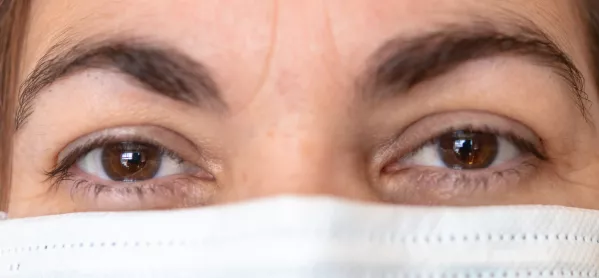Masked teaching: ‘My eyebrows are working overtime’

Once again, I find myself staring at a screen, thinking, “If this time last year you’d told me I’d be writing about this, I’d have thought you were crazy…”
Yet here we are: a week into full-on teaching while wearing a face covering. In front of a room full of teenagers also wearing face coverings.
We’ve had a gradual lead-in. The abrupt 180-degree turn in the supermarket car park to retrieve the face mask left on the dashboard is now part of the daily routine; last term, we wore face coverings in corridors.
But the shift to a full day in a mask - and the pupils in masks, too - feels sudden. I’m not complaining. I know we have to do this. And I know there are other jobs where face coverings have been essential workwear for a long time.
I’m just not quite as certain whether those people utter much more than a muted “Scalpel, nurse” from behind a mask, rather than reading aloud a chapter of The Wolves of Willoughby Chase, confirming several times the date is on the board, and explaining in detail why it might be a good idea to revise the theories of Baudrillard before attempting paper two, section B - all in day’s work for the average secondary school teacher.
Covid: Wearing a mask in the classroom
Speaking distinctly from behind layers of non-woven polypropylene is a challenge. As a teacher, my teenage dramatic society years spent honing the art of breathing from the diaphragm have come in useful: the ability to boom effortlessly across cavernous spaces, I would say, is one of my defining professional features.
This week, I’ve come to appreciate the wisdom of masked villains - Bane and Darth Vader spring to mind - who’ve built mouthpieces into their headgear in order to remain anonymous, and yet bring the residents of Gotham or the bridge of the Death Star to a juddering halt with a single resonant command. I could do with something like that to silence 30 chatty Year 10s in an echoing science lab.
As circulating around the classroom is unwise right now, there’s never been a time when a murmured reminder to an individual to turn around or stop talking or crack on with the last sentence is more needed. Consequently, my eyes and eyebrows have been working overtime this week: “the look” has been so well used my eyeballs are practically hanging out of my head.
Fortunately, I’m a practised eye-roller (great for the classroom but, I’ve recently learned to my cost, not quite so great for being a mic-off, camera-on participant in all-staff Teams meetings…). My eyeliner is usually full-on Theda Bara, so it’s been easy to build a repertoire of non-verbal cues - from “jolly well done” to “yes, I am disappointed” to “I’m going to have to ring home” - that’d put a silent-movie star to shame.
A ping-pong of indeterminate noises
Of course, in lessons, it works both ways. Just as I’ve found it difficult to make myself understood, it’s even more difficult to understand what masked students are saying.
What makes it worse is when they can’t hear when I tell them I can’t hear them - leading to a muffled ping-pong of indeterminate noises, which - roughly translated - mean, “I’ve got no idea what you’re saying.”
Low-level chitchat is almost impossible to pin down, and the time-honoured “I could see your lips move and hear sound come out” riposte to the petulant “I never even said owt…” is redundant.
Now, I’m aware that the US author Dr Naomi Wolf is very concerned about the detrimental effect that wearing masks may be having on our young people: that they’ve forgotten how to smile back, and their lower faces are “hanging inertly”.
Aside from the implausibly swift evolution over five days of in-class mask wearing - plus my strong suspicion that seeing Naomi Wolf smile may not automatically induce another human to smile back - my experience this week has been the opposite. Our students are as gloriously smiley and chatty and noisy as they’ve always been. They’re glad to be back in school - masks or no masks.
Finally, at the end of a long day’s work, there’s nothing quite like removing a face mask with an extravagant Mission Impossible-style manoeuvre and a careless Timotei-esque shake of the locks to signify freedom and allow the evening to begin. Once again, we adapt, move on and get the job done.
Sarah Ledger is an English teacher and director of learning for Year 11 at William Howard School in Brampton, Cumbria. She has been teaching for 34 years
You need a Tes subscription to read this article
Subscribe now to read this article and get other subscriber-only content:
- Unlimited access to all Tes magazine content
- Exclusive subscriber-only stories
- Award-winning email newsletters
Already a subscriber? Log in
You need a subscription to read this article
Subscribe now to read this article and get other subscriber-only content, including:
- Unlimited access to all Tes magazine content
- Exclusive subscriber-only stories
- Award-winning email newsletters